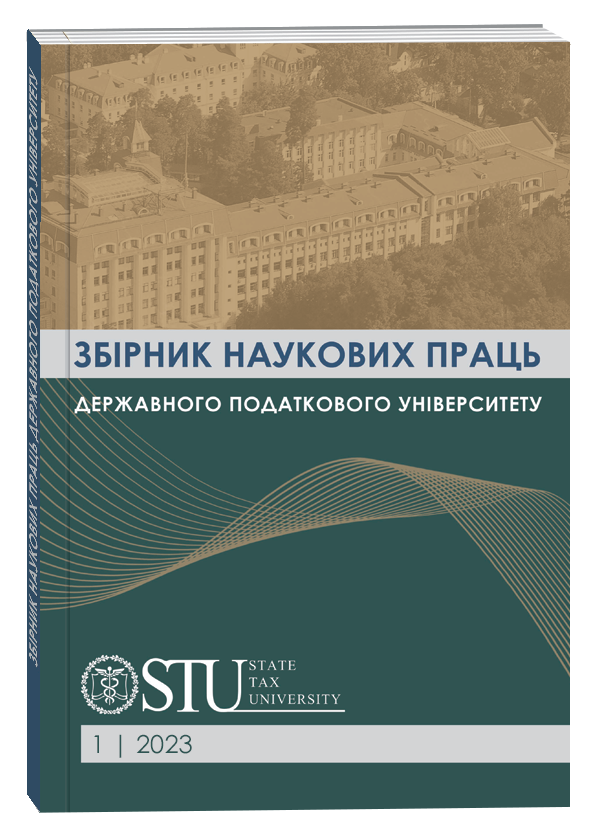SPECIALTY OF UNSCRUPULOUS ECONOMIC ACTIVITY
DOI:
https://doi.org/10.33244/2617-5940.1.2023.6-33Keywords:
unscrupulous financial activity, manipulative gap, time gap, consequential gap, financial fraudAbstract
The development and implementation of methods for detecting unfair financial activities, including financial fraud, is relevant today. After all, in the context of both the recent economic development and the functioning of Ukraine in the war regime, the problem of seizing financial resources as a result of unfair financial activities, including financial fraud, is particularly relevant. The acute urgency requires scientists to bring together in a single theoretical construct all the essential characteristics of unfair financial activity that are important for understanding its patterns, including the patterns of openly criminal activity in the economic space of our country. In view of this, an important attribute of the fight against unfair financial activity is the maximum completeness of understanding its characteristics. Such characteristics will be included in the development of methods and techniques for combating any manifestations of unfairness in the economic and financial spheres. In other words, this will help to formulate criteria and effective approaches to detecting, counteracting and preventing the loss of financial resources as a result of unfair practices. In Ukraine, during the war, there has been an increase in cases of unfair behavior on the part of economic and financial market participants. This inevitably leads to a loss of finances and undermines the credibility of the Ukrainian business sector. The formation of a specialty in unfair financial activities will also improve the level of training of law enforcement officers and specialists in corporate financial security, financial monitoring, etc. Based on a systematic analysis, the author identifies the unique characteristics of unfair financial activities. The study is based on the conceptual provisions of financial science. As a result of the study, the following characteristics of unfair financial activity were identified: rationality, causality, motivation, conditionality, scenario, organization, latency, pioneering, manipulative, professionalism, hybridity, integration, transformativity, mimicry, avatar, consequential gap, manipulative gap, time gap, non-discretion, informality, specificity of traces and non-contradiction of the law. The identification of the characteristics of unfair financial activities will allow for a more correct selection and application of methods and techniques for analytical detection, counteraction and prevention of financial and economic crimes. The results of the study will be useful for specialists in the investigation of crimes in the economic and financial spheres, for scientists with professional interests in the research and development of measures to prevent and neutralize unfair financial activities. The formation of a specialty in unfair financial activity will also improve the level of training of law enforcement officers and specialists in corporate financial security, financial monitoring, etc.
References
Adam Smith (2006). Supermoney. John Wiley & Sons, Inc., Foreword.
Велика українська енциклопедія. Тематичний словник гасел з напряму «Філософські науки» / уклад. А. В. Арістова, І. В. Шліхта ; за заг. ред. д-р істор. наук, проф. А. М. Киридон. К. : Державна наукова установа «Енциклопедичне видавництво», 2019. 256 с.
Чернявський С. С. Фінансове шахрайство: методологічні засади розслідування. К. : Хай-Тек Прес, 2010. 624 с.
CollinsDictionary. URL : https://www.collinsdictionary.com/dictionary/english/speciality
Joseph T. Wells (2007). Corporate fraud handbook. Prevention and detection. John Wiley & Sons, Inc.
Мошенський С. Більше ніж гроші. Фінансова історія людства. Київ : Саміт-книга, 2020. 504 с.
Никонович М., Барабаш Н., Міщенко А. Аудиторське оцінювання ризику шахрайства. Проблеми і перспективи економіки та управління : науковий журнал. 2016. № 3(7). С. 251–260.
Peter Lilley (2003). Dirty dealing. Kogan page.
Erik S. Reinert (2007). How rich countries got rich…and why poor countries stay poor. London : Constable.
Кара-Мурза С. Г. Власть манипуляции. 2017. 384 с.
Мамишев А. В. Ризикоорієнтований підхід до виявлення аудиторами фінансових шахрайств і злочинів із відмивання грошей. Фінанси України : науково-теоретичний та інформаційно-практичний журнал Міністерства фінансів України. 2013. № 4 (209). С. 80–88.
Adam Smith (2006). Supermoney. John Wiley & Sons, Inc., Foreword.
Velyka ukrainska entsyklopediia. Tematychnyi slovnyk hasel z napriamu «Filosofski nauky» / uklad. Aristova A. V., Shlikhta I. V. ; za zah. red. d. i. n., prof. Kyrydon A. M. K. : Derzhavna naukova ustanova «Entsyklopedychne vydavnytstvo», 2019. 256 s.
Cherniavskyi S. S. Finansove shakhraistvo: metodolohichni zasady rozsliduvannia. K. : Khai-Tek Pres, 2010. 624 s.
CollinsDictionary. URL : https://www.collinsdictionary.com/dictionary/english/speciality
Joseph T. Wells (2007). Corporate fraud handbook. Prevention and detection. John Wiley & Sons, Inc.
Moshenskyi S. Bilshe nizh hroshi. Finansova istoriia liudstva. Kyiv : Samit-knyha, 2020. 504 s.
Nykonovych M., Barabash N., Mishchenko A. Audytorske otsiniuvannia ryzyku shakhraistva. Problemy i perspektyvy ekonomiky ta upravlinnia : naukovyi zhurnal. 2016. № 3(7). S. 251–260.
Peter Lilley (2003). Dirty dealing. Kogan page.
Erik S. Reinert (2007). How rich countries got rich…and why poor countries stay poor. London : Constable. 10. Kara-Murza S. G. Vlast manipulyatsii. 2077. 384 s.
Mamyshev A. V. Ryzykooriientovanyi pidkhid do vyiavlennia audytoramy finansovykh shakhraistv i zlochyniv iz vidmyvannia hroshei. Finansy Ukrainy : naukovo-teoretychnyi ta informatsiino-praktychnyi zhurnal Ministerstva finansiv Ukrainy. 2013. № 4 (209). S. 80–88.



